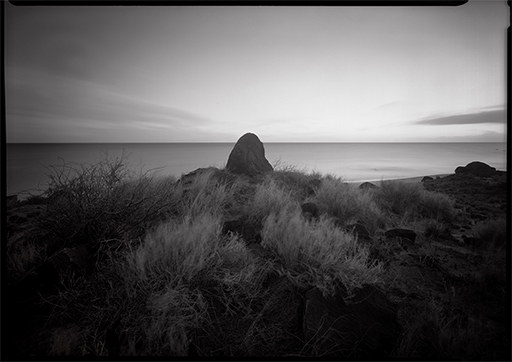Senator Daniel Akaka (D-Hawaii) address to US Senate
"Kaho'olawe: Rebirth of a Sacred Hawaiian Island": Address to US Senate by Senator Daniel Akaka on the occasion of the Smithsonian exhibition highlighting the island. June 10, 2002

Fishing Shrine, Kaho‘olawe, HI 1994
Mr. President, I rise today to call my colleagues attention to an excellent exhibit that opened last week at the Smithsonian Institution's Arts and Industries Building, entitled, "Kaho'olawe: Rebirth of a Sacred Hawaiian Island." The exhibit chronicles the rich history of the island of Kaho'olawe from its mythical beginnings to current efforts towards its protection and revitalization. The exhibit is a project of the Bishop Museum Native Hawaiian Culture and Arts Program, and is sponsored by the Smithsonian Asian Pacific American Program, Bernice Pauahi Bishop Museum, Community Development Pacific, and Protect Kaho'olawe 'Ohana/Fund.
I was deeply moved by the exhibit and its eloquent reflection of the Hawaiian value of "aloha 'aina," which means love for the land, which serves as a foundation for the culture of Hawaii's indigenous peoples: the Native Hawaiians. The profound appreciation for Hawaiian culture and its values is reflected in Hawaii's state motto, Ua mau ke'ea 'o ka 'aina 'i ka pono, "the life of the land is perpetuated in its righteousness." The exhibition celebrates Hawaii's culture and people in telling the story of Kaho'olawe.
Ancient chants—plaintive and poetic oral histories of Hawaii—along with archaeological evidence indicate that Kaho'olawe was inhabited by Native Hawaiians who fished and farmed in coastal and upland settlements scattered across the island. In ancient times, the island was referred to as Kanaloa for the god of the ocean and the foundations of the earth.
From 1941 to 1994, Kaho'olawe and its surrounding waters were under the control of the United States Navy. Both the island and the waters of Kaho'olawe were used as a live-fire training range. In 1990, President George Bush directed the Department of Defense to cease using the island of Kaho'olawe as a training range. In 1993, Congress enacted legislation that recognized the cultural significance of Kaho'olawe, required its return to the State of Hawaii, and directed the Navy to conduct unexploded ordnance cleanup and environmental restoration in partnership with the State of Hawaii. Congress authorized federal funding through 2003 for the cleanup of Kaho'olawe. We continue to work with the Navy to ensure that this funding is utilized for maximum cleanup of the island before access is turned over to the State of Hawaii in late 2003.
The restoration of Kaho'olawe is more than the cleanup of ordnance. Native Hawaiians also referred to Kaho'olawe as "Ko Hema Lamalama," the Southern Beacon, in reference to the island's use as a navigational aid, or shining beacon, for long-distance voyagers returning to Hawaii. For many Hawaiians, the vision of a fully restored Kaho'olawe serves as a guiding light to the revitalization of Native Hawaiian culture.
I encourage all of my colleagues and their staff to visit this exhibit at the Smithsonian Institution's Arts and Industries Building. I always welcome the opportunity to share the true essence of Hawaii with my colleagues and our fellow citizens on the U.S. mainland. We have the honor and privilege of showing you a bit of Hawaii in Washington, D.C., until September 2, 2002, and I invite you to share in this wonderful experience.
I request unanimous consent that my full statement be printed in the Record.